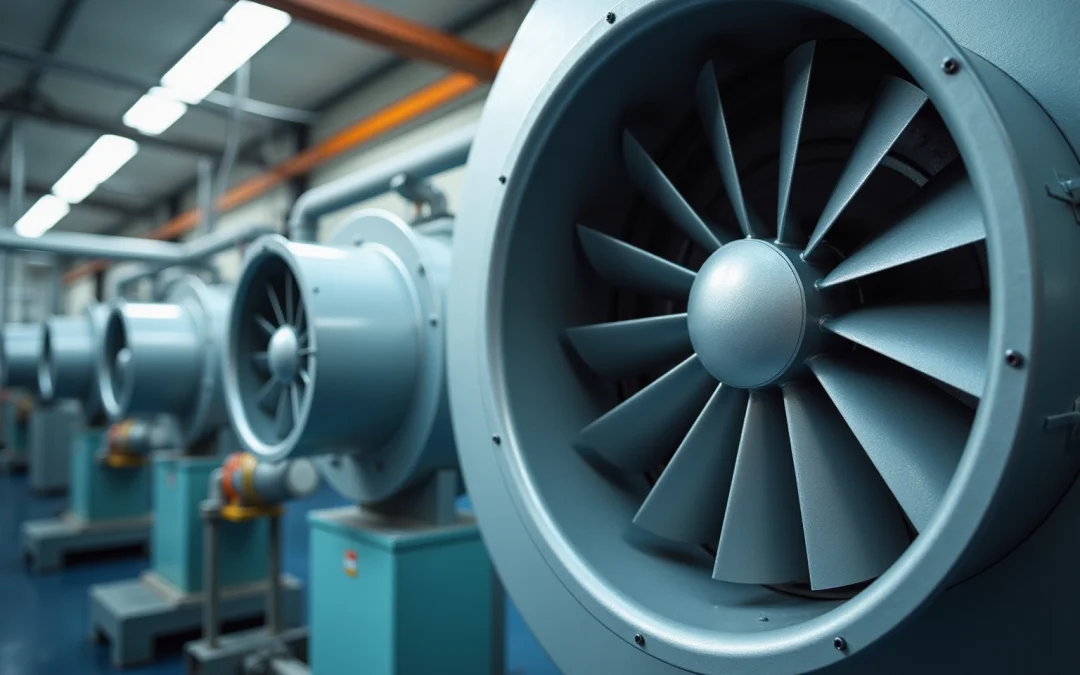Overview
Centrifugal fans are sophisticated mechanical devices engineered to move air or gases at right angles to the axis of rotation. Their primary function is to generate airflow by converting rotational energy into kinetic energy. This technology is pivotal in various applications, including HVAC systems, dust collection, and cooling processes.
The significance of centrifugal fans cannot be overstated; they offer distinct advantages such as:
- Higher pressure generation
- Stable airflow
- Energy efficiency
These characteristics render them indispensable in modern industrial settings, where optimized performance and reliability are paramount.
Introduction
Centrifugal fans play a crucial role in a multitude of industrial applications, expertly designed to efficiently move air or gases by transforming rotational energy into kinetic energy. As industries increasingly depend on these devices for ventilation, cooling, and air filtration, a comprehensive understanding of their function and operation becomes essential. With rapid advancements in fan technology and a growing emphasis on energy efficiency, businesses must consider how to leverage the most effective centrifugal fan solutions tailored to their specific requirements.
Define Centrifugal Fan: Function and Purpose
Centrifugal blowers, which are often explained as what is centrifugal fan, are mechanical devices expertly engineered to move air or gases at a right angle to the axis of rotation. To understand what is centrifugal fan, it is important to know that their primary function is to generate airflow by converting rotational energy from the motor into kinetic energy in the air. This transformation is facilitated by an impeller that accelerates air outward, which exemplifies what is centrifugal fan, creating a pressure difference that draws additional air into the fan.
In HVAC systems, rotary blowers play a critical role, accounting for over 32% of the market share in 2023 due to their effectiveness in ventilation, cooling, and air filtration tasks. Recent advancements in fan technology have resulted in the emergence of energy-efficient models that incorporate IoT capabilities, enabling real-time adjustments based on occupancy and air quality.
Key characteristics of these devices include:
- Their ability to maintain steady airflow
- Minimal maintenance requirements
- Versatility across various industrial applications
For instance, in the manufacturing sector, rotary blowers are utilized for effective air circulation and temperature regulation, thereby enhancing both productivity and occupant comfort. As industries increasingly prioritize energy conservation and sustainability, the demand for sophisticated rotary blowers continues to rise, underscoring their essential role in modern HVAC systems.
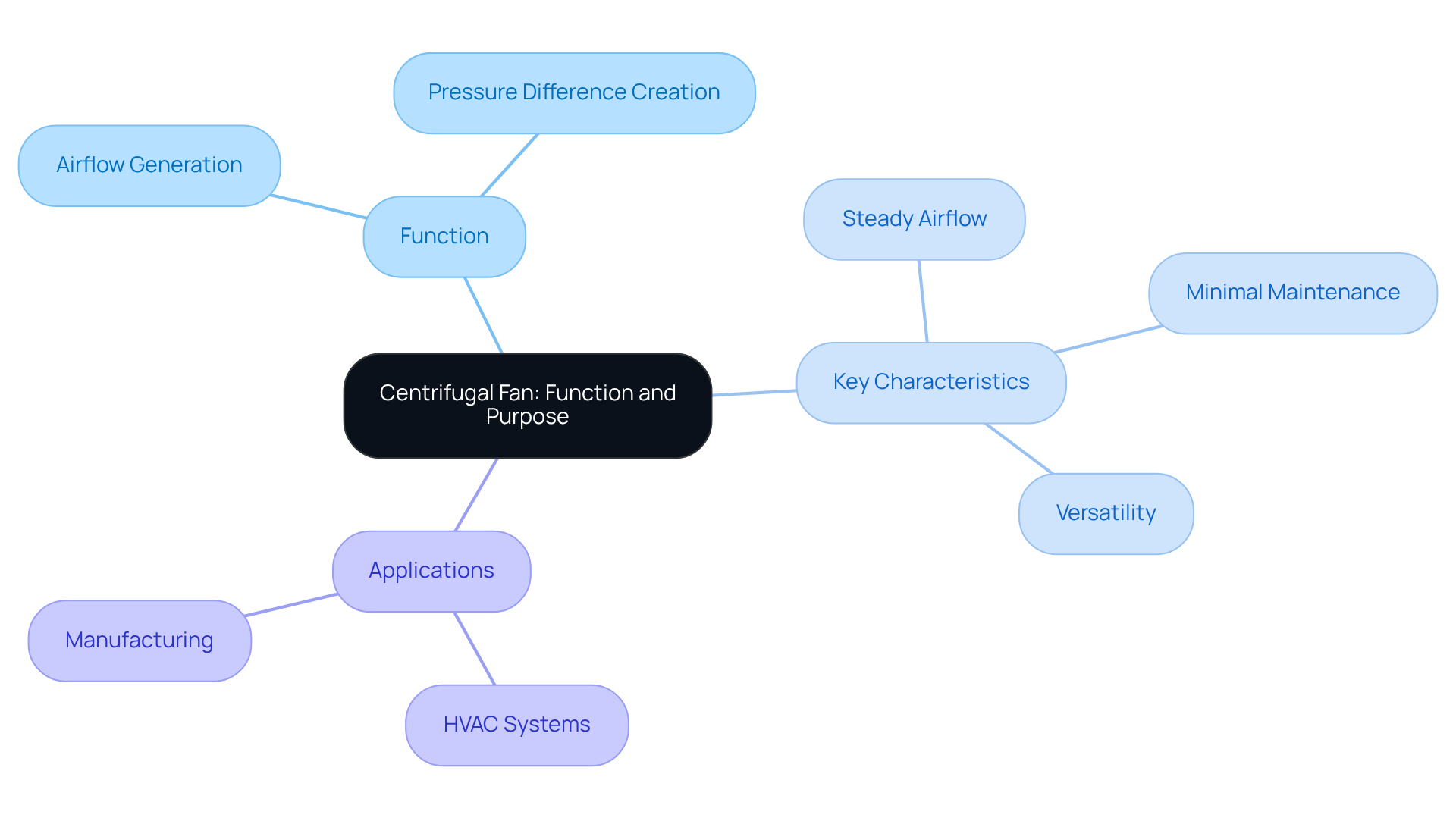
Explain How Centrifugal Fans Operate: Principles and Mechanics
Radial blowers operate based on the principle of radial force. When the impeller, featuring blades arranged in a circular pattern, rotates, it draws air into the center of the fan. As the air enters, the blades accelerate it radially outward. This acceleration increases both the velocity and pressure of the air, enabling it to exit the fan at a right angle to the intake direction.
The design of the fan casing, often spiral in shape, plays a critical role in converting the kinetic energy of the air into pressure energy, thereby enhancing the performance of the fan. The efficiency of centrifugal blowers can be affected by various factors, including:
- Blade design
- Rotational speed
- Housing configuration
For instance, backward inclined blowers typically achieve higher static pressure and overall performance compared to alternative designs. Recent studies reveal that optimizing blade geometry can lead to significant enhancements in airflow and static pressure capabilities. Noteworthy statistics, such as the maximum flow rate of the RT Series unit reaching 700,000 m³/h and power loss during peak performance being less than 1%, emphasize the critical nature of design in attaining superior efficiency ratings relative to axial models.
Furthermore, understanding what is centrifugal fan, along with the mechanical principles underlying rotational force and airflow dynamics, is essential for engineers aiming to improve the efficiency of these fans across various industrial applications. It is equally important to consider the effect of temperature on rotational force, as this can influence operational limits. Key terms such as ‘rotational force’ and ‘static pressure’ are vital for grasping the concepts integral to fan operation.
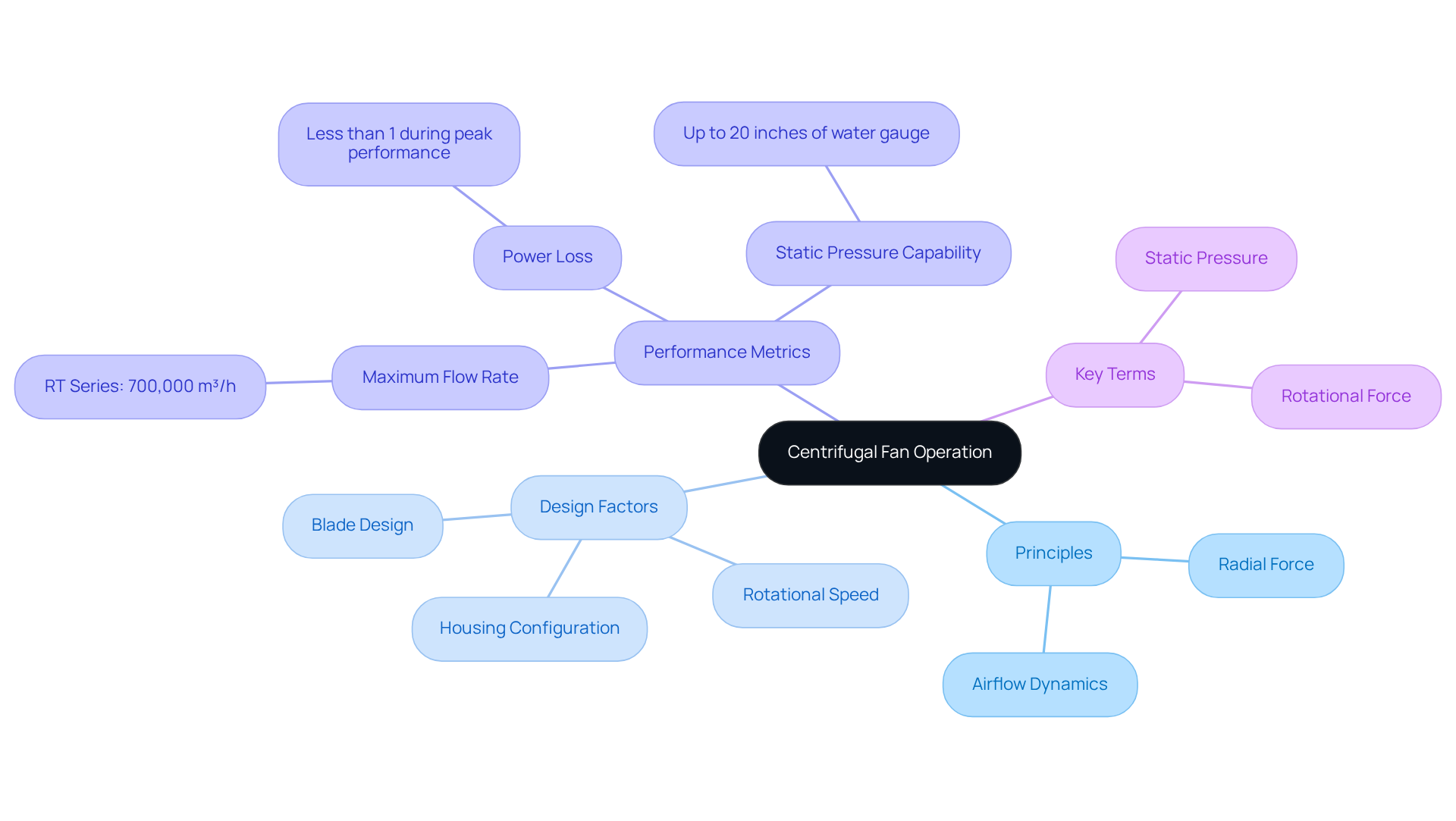
Identify Common Applications of Centrifugal Fans in Industry
Centrifugal blowers, often referred to as what is centrifugal fan, are indispensable components across various sectors, serving multiple functions that enhance operational efficiency and safety. Their key applications include:
- HVAC Systems: Central to heating, ventilation, and air conditioning systems, centrifugal fans facilitate optimal airflow for effective temperature regulation, thereby enhancing energy efficiency and comfort in indoor environments. Experts assert that knowing what is centrifugal fan is crucial for maintaining air quality and energy efficiency in HVAC applications.
- Dust Collection: Within manufacturing and processing facilities, these fans are vital for dust extraction and air filtration, aiding compliance with stringent air quality standards. Their robust design allows for effective management of air laden with particles, significantly improving dust collection performance. The centrifugal duct fan market is projected to reach USD 1.8 billion by 2033, growing at a CAGR of 5.0% from 2026 to 2033, reflecting the rising demand for efficient dust collection solutions.
- Cooling Applications: Centrifugal blowers are employed to cool electronic components, machinery, and industrial processes, preventing overheating and sustaining operational efficiency. Their capacity to generate high-pressure airflow renders them ideal for cooling applications in data centers and industrial settings. Recent advancements in fan technology have further augmented their cooling capabilities.
- Material Handling: These devices facilitate the movement of materials in pneumatic conveying systems, effectively transporting powders and granules. Their design ensures reliable operation in demanding environments, promoting smooth material flow.
- Fume Extraction: Essential for workplace safety, rotating blowers are utilized to remove harmful fumes and gases from industrial environments. By preserving air quality, they contribute to a safer working atmosphere and adherence to health regulations.
The growing demand for energy-efficient ventilation solutions, along with advancements in blower technology, is driving the evolution of rotating units, including what is centrifugal fan, making them indispensable in modern industrial applications. Various types of centrifugal blowers, including forward-curved and backward-curved models, are engineered for specific applications, enhancing their efficiency in diverse scenarios.
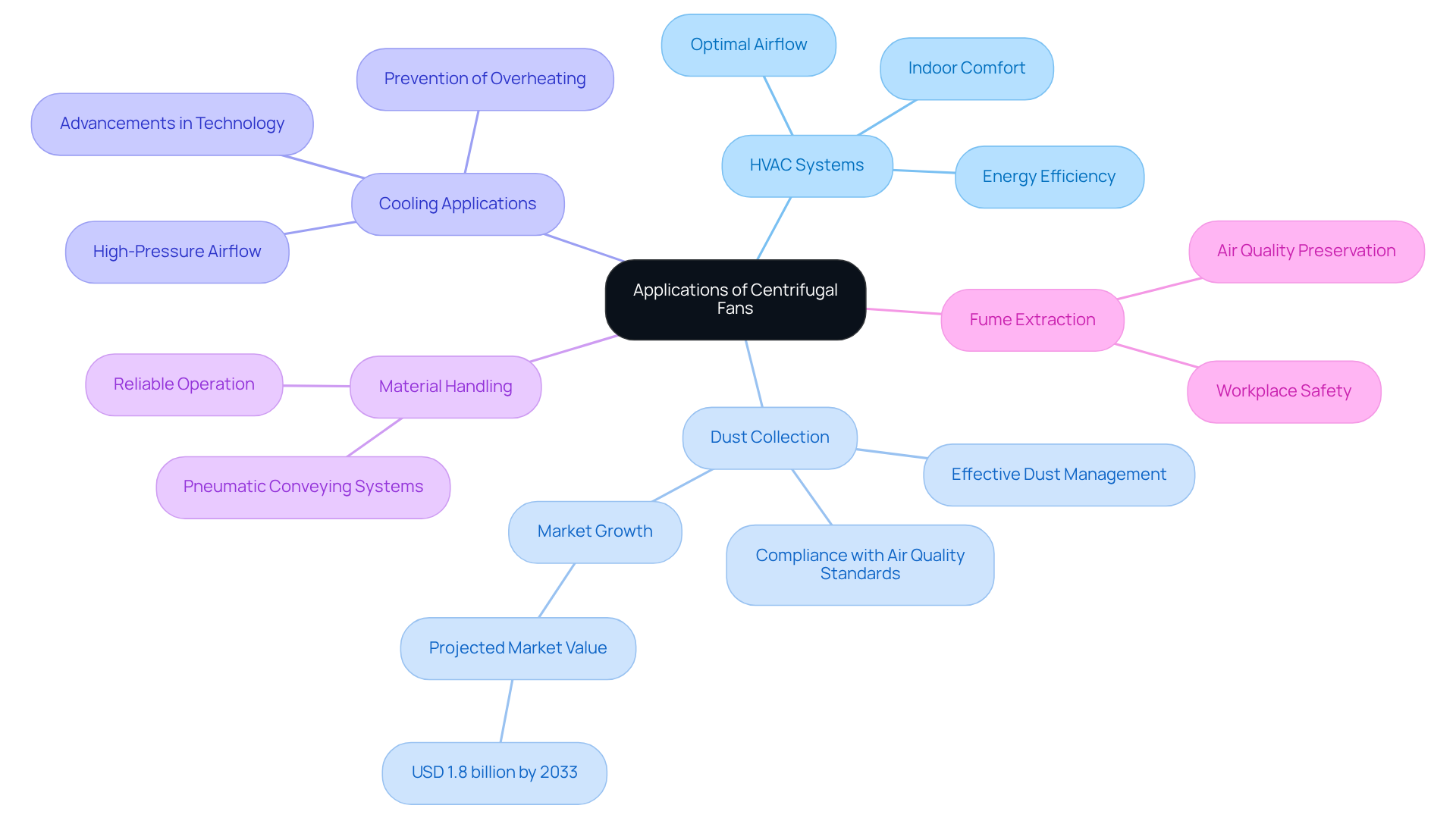
Outline Advantages of Centrifugal Fans Compared to Other Fan Types
Centrifugal blowers, which exemplify what is centrifugal fan technology, present distinct advantages over other ventilator types, particularly axial models, establishing themselves as a preferred choice across various industrial applications. The primary benefits include:
-
Higher Pressure Generation: Centrifugal fans are adept at producing elevated static pressure, essential for scenarios requiring airflow through ducts or against considerable resistance. This capability is vital in settings where sustaining airflow is crucial for operational efficiency.
-
Stable Airflow: These devices deliver consistent and stable airflow, a fundamental aspect for processes that depend on precise air movement. Their design minimizes fluctuations in airflow, thereby enhancing the reliability of systems reliant on a steady air supply.
-
Versatility: Centrifugal blowers are inherently adaptable, capable of managing a broad spectrum of airflows and pressures. This versatility enables them to cater to diverse industrial requirements, ranging from ventilation to cooling applications.
-
Durability: Built to withstand harsh environments, rotating blowers effectively manage dust, moisture, and corrosive gases. Their robust construction guarantees longevity and dependable performance in challenging conditions. For example, RHF’s Smoothflow technology enhances durability by reducing wear and tear, ensuring these devices operate efficiently in demanding environments.
-
Energy Conservation: Many centrifugal blowers are engineered for energy efficiency, significantly reducing operational costs while maintaining high performance. They can achieve up to 84% static performance. Considering that supporters consume approximately 78.7 billion kilowatt-hours annually in the manufacturing sector—accounting for 15% of electricity used by motors—enhancing energy efficiency is crucial for cost savings and sustainability. As noted by RHF Fans, their innovative designs address core issues of energy consumption and airflow optimization, setting a new benchmark for performance.
In conclusion, the amalgamation of high-pressure capabilities, stable airflow, versatility, durability, and energy efficiency makes it clear what is centrifugal fan as an exceptional choice for industrial applications, ensuring effective performance in demanding environments.
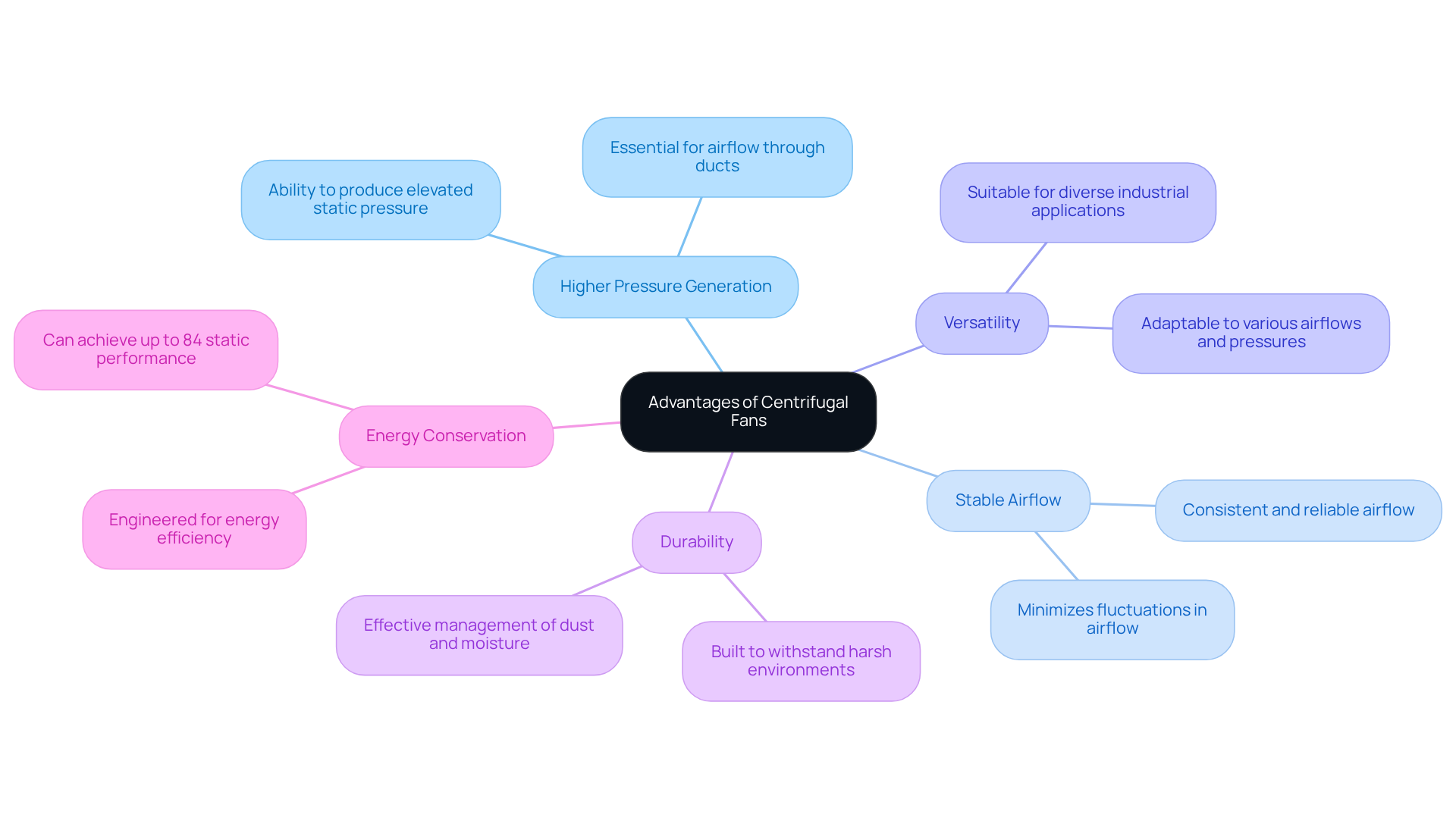
Conclusion
Centrifugal fans are indispensable in a multitude of industrial applications, adeptly moving air or gases at right angles to their axis of rotation. Their capability to transform rotational energy into kinetic energy facilitates effective airflow generation, establishing them as crucial components in HVAC systems, dust collection, cooling applications, and beyond. A comprehensive understanding of the intricate mechanics and varied functionalities of these fans underscores their importance in enhancing operational efficiency and maintaining air quality across diverse sectors.
Key insights into centrifugal fans reveal their:
- stable airflow
- high-pressure generation
- durability
- energy efficiency
These attributes not only emphasize their superiority over axial fans but also highlight their versatility in addressing diverse industrial requirements. As industries increasingly prioritize sustainability and energy conservation, the demand for advanced centrifugal blowers is on the rise, reflecting their essential role in contemporary operations.
Given the heightened focus on energy-efficient solutions, it is imperative for industries to consider the integration of centrifugal fans. By optimizing airflow and minimizing energy consumption, these fans can substantially enhance operational efficiency and contribute to environmental sustainability. Embracing advancements in fan technology will ensure that industries remain competitive while prioritizing safety and efficiency in their processes.
Frequently Asked Questions
What is a centrifugal fan?
A centrifugal fan is a mechanical device designed to move air or gases at a right angle to the axis of rotation, converting rotational energy from the motor into kinetic energy in the air.
How does a centrifugal fan generate airflow?
A centrifugal fan generates airflow by using an impeller that accelerates air outward, creating a pressure difference that draws additional air into the fan.
What role do centrifugal fans play in HVAC systems?
In HVAC systems, centrifugal fans are crucial for ventilation, cooling, and air filtration, accounting for over 32% of the market share in 2023.
What are some recent advancements in centrifugal fan technology?
Recent advancements include the development of energy-efficient models that incorporate IoT capabilities for real-time adjustments based on occupancy and air quality.
What are the key characteristics of centrifugal fans?
Key characteristics include the ability to maintain steady airflow, minimal maintenance requirements, and versatility across various industrial applications.
How are centrifugal fans used in the manufacturing sector?
In the manufacturing sector, centrifugal fans are used for effective air circulation and temperature regulation, enhancing productivity and occupant comfort.
Why is there an increasing demand for rotary blowers?
The demand for rotary blowers is rising as industries prioritize energy conservation and sustainability, highlighting their essential role in modern HVAC systems.

